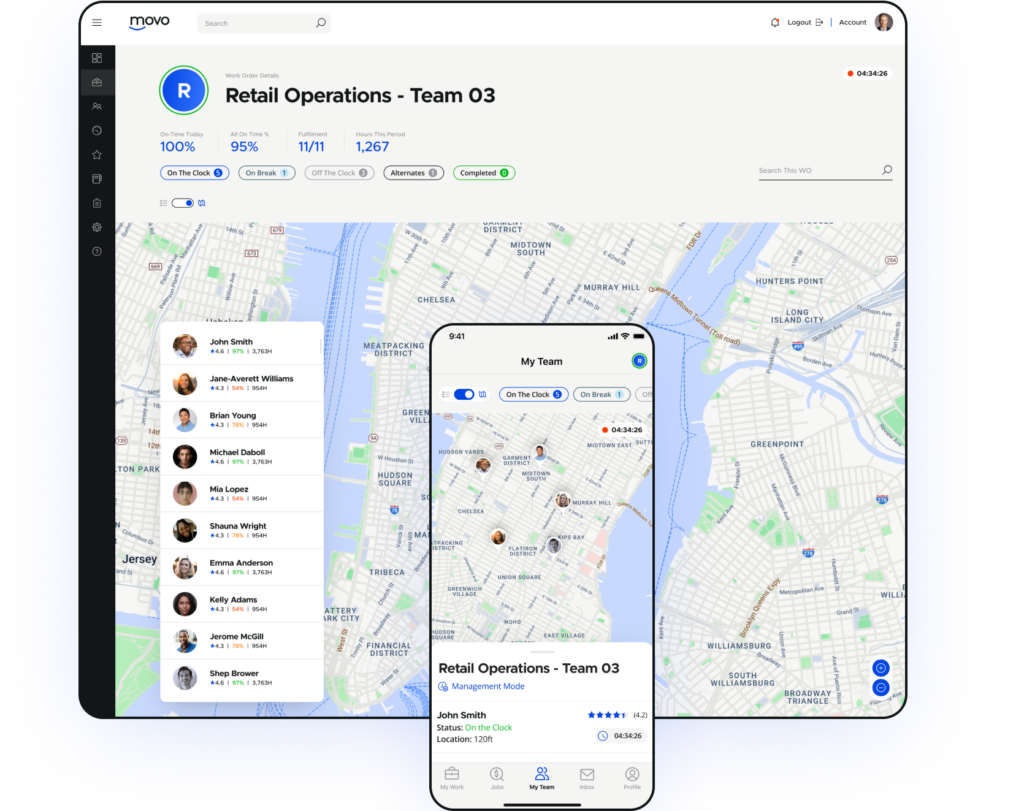According to a 2019 Gartner report, over 50% of corporations used various employee tracking techniques, such as collecting biometric data and text analysis. The number of companies adopting these solutions continues to grow, unsurprisingly accelerated by the Covid-19 pandemic, which significantly disrupted the balance between in-office and remote work. To maintain productivity, companies had to implement new tools to monitor employees who no longer came to the office. The technology market rapidly advanced, offering solutions that measure everything from employees’ heart rates to their eye movements.
However, technological advancements do not necessarily translate into real benefits from tracking hundreds of metrics. This article provides essential tips on how to plan an employee monitoring strategy in a sensible and effective manner. Learn about the pros and cons of employee monitoring.
What is Employee Monitoring?
Employee monitoring is the process of collecting data related to specific employee activities. This data is intended to help optimize individual productivity, motivate engagement, and identify areas for improvement. Both parties – the employer and the employee – agree on the terms of cooperation, including the conditions under which monitoring will occur and the tools that will be used. This practice is considered a good management strategy. Employees receive feedback and guidance to help them develop, while employers can ensure the efficient use of resources.
However, monitoring can quickly lose its positive impact if the employer:
- Begins to collect data on employee behavior outside of work hours (e.g., tracking a company vehicle given to the employee for personal use outside of work hours, even though the employee has permission to use it for personal purposes);
- Collects data unrelated to employee performance (e.g., using software to track facial expressions and using this information against the employee);
- Gathers data that may lead to unproductive behaviors or decreased employee engagement (e.g., superficially analyzing moods without deeper research or attempts to understand temporary drops in performance).
Types of Employee Monitoring
Companies monitor employee activities in various ways for different reasons, such as:
- Preventing data security breaches, like sensitive data leaks via email.
- Preventing workplace theft.
- Ensuring employees do not use company equipment or vehicles for personal purposes.
- Increasing employee engagement and productivity.
- Optimizing workflows or business processes.
- Maintaining a current overview of each team member’s work and employee activities.
Therefore, many alternative solutions are available on the market.
Phone and Video Surveillance
Phone and video surveillance are commonly used in many workplaces, such as customer service centers, where a single inadvertent word in a conversation can result in significant costs for the company. This type of monitoring can include recording phone conversations or monitoring phone usage. Video surveillance primarily involves cameras inside and outside the company premises to prevent theft and ensure security. It is one of the most traditional methods of employee surveillance, which has led to specific regulations and monitoring laws in many countries. For instance, in some countries, it is only permissible to record images, not sound. For example, the General Data Protection Regulation imposes a comprehensive set of rules regulating video and audio.
Internet Usage and Email Monitoring
Monitoring internet and email usage primarily involves tracking the websites employees visit using company devices and reviewing the emails they send and receive (only work-related emails, of course!). These activities aim to ensure that employees do not engage in non-work-related activities during work hours and do not send confidential information via email. Common tools for this purpose include applications that report browsing history, take periodic screenshots, or measure bandwidth usage to prevent, for example, downloading files from the internet.
Location Tracking and GPS Tracking Software
Location and GPS tracking software is particularly favored by companies employing remote employees, such as logistics and transportation companies, as well as businesses where employees use company vehicles (e.g., sales representatives). These tools track employees’ real-time locations, allowing verification that they are following designated routes or visiting specified places. This helps optimize routes, ensure timely deliveries, and enhance overall operational efficiency while preventing resource wastage.
Employee Monitoring Software
Employee monitoring software encompasses various tools designed to track computer activity, application usage, and productivity levels. These tools can monitor keystrokes (keylogging software), screen activity, and the use of specific applications. They provide detailed information on how employees spend their time at work and can help identify productivity patterns or areas needing improvement. Among these tools are also HR platforms with time-tracking features, supporting appropriate task allocation, proper shift assignments, and preventing legal complications related to labor law.
How to Choose the Right Employee Monitoring Technology?

Choosing the right employee monitoring technology depends on the company’s business needs, employee roles, and the ability to integrate new tools with the company’s technology stack. The tool should comply with local or national legal regulations, and if the company has branches in different countries, it should also comply with international monitoring laws.
The chosen solution should be user-friendly and inclusive (considering the needs of visually impaired, hearing impaired, or colorblind individuals) and scalable. It must handle a growing number of employees and expanding operational requirements. And the cost? Well, that’s an individual matter for each company, but when considering this aspect, it’s essential to verify all additional fees associated with the investment, such as implementation fees, maintenance expenses, update costs, support costs, etc.
Pros of Employee Monitoring
Employee monitoring can bring many benefits to a company if two conditions are met: the monitoring tools are well-suited to the company’s needs, and the team is properly trained and understands that monitoring their own productivity is the first step to professional growth.
Here are some key advantages of employee monitoring.
Increased Employee Productivity
One of the primary benefits of employee monitoring is higher productivity. Not only can you quickly identify team members who waste time surfing the web or pseudo-networking on Facebook, but you can also find out who is overloaded with tasks. This helps in better task allocation and fair distribution of workload across the team. The very awareness of being monitored often encourages employees to stay engaged and productive, reducing instances of idleness or handling personal matters during work hours.
Greater Disciplinary Effectiveness
Employee monitoring helps curb behaviors that border on the edge of legality. Chronic tardiness or shift swaps that cause legal trouble can be significantly reduced. Monitoring software also effectively tracks remote or hybrid employees, whose behaviors aren’t visible to office cameras.
Enhanced Security
Employee monitoring increases workplace security and cybersecurity. In the age of remote work and the use of company devices, monitoring systems help protect sensitive data effectively (e.g., preventing the connection of USB drives to company devices or copying and sharing files externally). Video surveillance, keylogging software, and GPS tracking can detect and prevent unauthorized access to company information, ensuring adherence to safety protocols.
Improved Compliance with Regulations
Compliance with legal and regulatory requirements is another significant advantage of using employee monitoring technology. Monitoring software can help companies adhere to regulations such as the General Data Protection Regulation (GDPR) and the Electronic Communications Privacy Act (ECPA). By tracking employee activity and maintaining detailed records, companies can demonstrate their compliance efforts to avoid legal trouble. Moreover, monitoring tools act as a deterrent, encouraging employees to follow company policies and industry standards, thereby reducing the risk of non-compliance penalties.
Better Resource Management
Effective resource management is key to profitable operations. Employee monitoring tools provide valuable data on the use of resources such as time, company vehicles, and work devices. This information helps companies optimize resource allocation, reduce waste, and improve operational processes.
Employee Performance Evaluation and Feedback
Monitoring employee performance using various tools allows managers to collect accurate and objective data on employee activities and achievements. This data is invaluable for performance evaluations. With detailed performance metrics, managers can offer constructive feedback, set realistic goals, and implement personalized development plans. Informed consent and transparency in monitoring practices can also lead to more engaged employees who appreciate clear expectations and regular feedback.
Cons of Employee Monitoring
While using various employee monitoring tools has clear benefits, we cannot ignore the potential drawbacks and employee concerns that come with them.
Here are some of the key issues.
Serious Risk of Data Breaches
Any company that monitors employee behavior and collects data must be prepared for potential cyberattacks and data theft attempts. If your system is hacked, employee privacy could be compromised or exposed, leading to serious consequences.
Privacy Concerns
One of the most significant issues related to employee monitoring is privacy concerns. Tools like keylogging software, GPS tracking, and video surveillance can intrude on employees’ personal space and activities. Collecting extensive employee monitoring data, including sensitive information, can lead to discomfort and a sense of privacy invasion. This, in turn, may result in decreased employee morale and trust, as well as increased turnover.
Potential for Employee Distrust
Excessive monitoring can create a culture of management by fear. Employees may feel that their employer does not trust them to perform their duties without constant oversight. This sentiment can lead to decreased engagement and productivity, as employees feel demotivated and undervalued. In such situations, informing employees about the legitimate business reasons for monitoring and ensuring transparency in monitoring practices is absolutely essential.
Legal and Ethical Issues
Implementing employee monitoring systems can also raise various legal and ethical concerns. Companies must navigate complex regulations, and failing to comply can result in significant fines and legal repercussions. Ethical considerations around monitoring employee activities and electronic communications also need to be addressed – determining which data to collect, which is valuable, and which might be so sensitive that processing it crosses ethical boundaries.
High Implementation Costs
Implementing a comprehensive employee monitoring system can be expensive. Costs include purchasing and maintaining monitoring software, training staff to use it, and potentially hiring additional personnel to manage the monitoring processes. This can be a major hurdle for small and medium-sized businesses.
Risk of Misuse and Over-Surveillance
There is a risk of misuse and over-surveillance when implementing employee monitoring systems. Managers might overstep their boundaries and monitor employees outside of work hours, creating an unhealthy team atmosphere or leading to unfair discrimination against specific employees.
Best Practices for Employee Monitoring
Effectively implementing employee monitoring requires a balanced approach that prioritizes employee privacy while providing essential productivity data, all within ethical and legal boundaries.
Here are some best practices to consider.
Transparent Communication
Follow the example set by Microsoft and end productivity paranoia. Employees who don’t trust their employers are not productive. Let transparency drive your actions. Inform employees about the reasons for monitoring, the tools, and methods used, and the types of data collected. Clear communication helps employees understand the legitimate business reasons behind monitoring practices and reduces feelings of distrust. Don’t forget to regularly update employees about any changes in this area!
Balancing Monitoring and Employee Privacy
Balancing the need for monitoring with respect for employee privacy is critically important. Avoid excessive monitoring that intrudes on personal space or activities. Focus on collecting data that is relevant to your business processes and handle sensitive data with care, such as using data anonymization techniques whenever possible.
Regular Review and Adjustment of Monitoring Policies
Monitoring policies should not be static. Regularly review and adjust them to adapt to changing business needs, legal requirements, and technological advancements. Conduct periodic audits of monitoring practices to ensure they remain ethical, legal, and effective.
Involving Employees in Policy Development
Involving employees in the development of monitoring policies fosters a sense of ownership and acceptance. Why not create a team to meet with management and provide input on monitoring practices and express their concerns? This approach ensures that policies are fair and consider employee perspectives, leading to higher acceptance and compliance.
A Few Recommendations for Employers and Employees
Finally, here are some concise recommendations for both parties.
For Employers:
- Use monitoring tools that align with business objectives and respect employee privacy.
- Ensure all monitoring activities are legal and ethical.
- Regularly train employees on how monitoring tools work and the importance of data security.
- Use monitoring data to support employee development, not just for disciplinary actions.
For Employees:
- Understand the reasons behind workplace monitoring. It can benefit both the company and you.
- Use feedback from monitoring data to improve your performance and productivity.
- Communicate any concerns about monitoring practices with management to promote open dialogue.
By following these best practices, employers can effectively implement employee monitoring systems that enhance productivity and security while maintaining a positive and respectful work environment. Balancing the cons and pros of employee monitoring is crucial to achieving these goals, ensuring that monitoring practices are both beneficial and fair.
Final Thoughts on Employee Monitoring
Employee monitoring is a powerful tool that can significantly enhance employee productivity and business efficiency when used correctly. However, it is essential to balance the benefits with the potential drawbacks to ensure a positive workplace environment. Transparent communication, respect for employee privacy, regular policy reviews, and involving employees in policy development are critical best practices to achieve this balance.
Employers should use monitoring tools to support employee development and business processes while adhering to legal and ethical standards. By doing so, they will leverage the advantages of employee monitoring while maintaining trust and morale within their teams.
If your team works remotely or in a hybrid setup, or if you manage a mobile workforce, start enhancing productivity with a solution like Movo.

Movo is a constantly evolving HCM software solution that adapts to the changing needs of various industries. It will surely become your favorite employee monitoring software, using attendance data to track work hours and meet all your team’s needs.
✅ Stay informed with geotagging to enhance accuracy in time recording for your mobile workforce and prevent time theft with a mobile clock and software alerts.
✅ Base wage decisions on app logs rather than traditional paper attendance records.
✅ Calculate the time needed to complete tasks for statistical analysis and utilize reliable data to better plan tasks and save time.
✅ Ensure all shifts are scheduled in compliance with regulations. Allow employees to pick up extra shifts or exchange shifts without regulatory issues.
✅ Enjoy the advantages of scheduling features, leave management, substitutions, and AI-driven workforce forecasting.
✅ Leverage real-time HR data insights and analytics to always have the right staff on shift.
✅ Efficiently handle time-off requests and schedule leaves remotely, while considering employee preferences.
✅ Benefit from extensive integration options with various tools and more!
Our goal is to help you improve your processes and drive your business value through streamlined workforce management and AI functionality.



